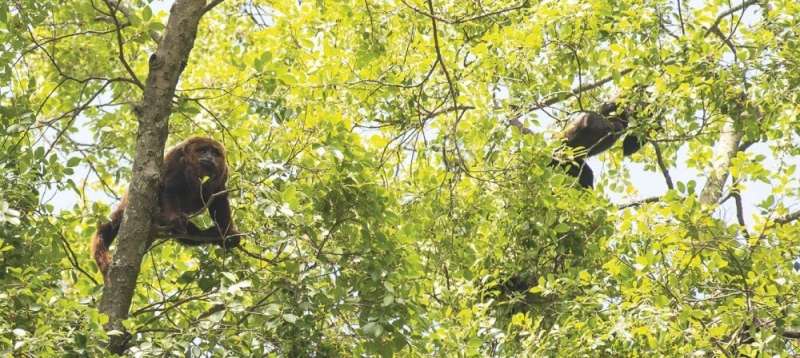Researchers use genomics to reconstitute yellow fever outbreak in Sao Paulo

Yellow fever virus is normally confined to the Amazon region, but the virus circulated in the Southeast of Brazil between 2016 and 2018, causing the worst epidemic and epizootic outbreaks there for decades. The Ministry of Health confirmed 2,251 cases of yellow fever in humans and 1,567 cases in monkeys in Brazil between December 2016 and June 2019.
According to a study published in the journal PLOS Pathogens, the three epidemic/epizootic waves that occurred in this period in the state of São Paulo, the most populous in the Southeast region, were caused by different lineages of the virus. In the first wave (July 2016-January 2017), the virus entered the state from the north, probably coming from neighboring state Minas Gerais, and spread mainly in cities such as São José do Rio Preto and Ribeirão Preto. The second wave (February-June 2017) was more intense, washing over the area from the border with Minas Gerais at Poços de Caldas all the way to Campinas. The largest number of cases was notified in the third wave (July 2017-February 2018). After reaching São Paulo City, the virus spread south to the Ribeira Valley area, where it found densely populated cities with low vaccination coverage rates and became a major public health problem.
These findings, reported in the journal by an international group of researchers supported by FAPESP, were based on genomic analysis of 51 viral isolates extracted both from mosquitoes collected in the affected areas and from monkeys that died from the disease. The material was sent by the Center for Epidemiological Surveillance (CVE) – an agency of the São Paulo State Department of Health—to Adolfo Lutz Institute (IAL), the central laboratory for public health in São Paulo.
"Based on the geographical and temporal distribution of the cases in non-human primates, on phylogenetic analysis [studying the mutations in the viral genome that lead to the emergence of novel lineages] and on phylogeographical analysis [studying the processes that determined the geographical distribution of the different lineages], it was possible to pinpoint when the virus entered the state of São Paulo, how fast and which way it spread, and all facets of its circulation," Renato de Souza, a researcher at IAL and one of the lead authors of the article, told Agência FAPESP.
This level of detail in the description of an epidemic was only possible thanks to the use of MinION genetic sequencing technology, Souza explained. The platform is portable, fast and cheap, permitting real-time monitoring of cases at the location where they are happening.
The strategy was first used in Brazil in 2016 to track the movement of zika virus in the Americas. More recently it has helped researchers at the Brazil-UK Center for Arbovirus Discovery, Diagnosis, Genomics and Epidemiology (CADDE) track the progress of COVID-19 in Brazil. The project is led by Ester Sabino, a researcher at the University of São Paulo, and Nuno Faria at the University of Oxford in the UK, and is supported by FAPESP, the UK Medical Research Council and the Newton Fund.
Accidental host
Yellow fever virus circulates permanently in the Amazon region and occasionally meets favorable conditions that let it escape. For this to happen, Souza explained, a population of the vector mosquito has to come into contact with a population of wild primates that is dense enough to maintain the chain of transmission for some time.
"This expansion isn't permanent," he said. "The virus eventually loses the capacity to circulate in the environment concerned and returns only if it's reintroduced. Between 2016 and 2018, the circulation area expanded to an unprecedented extent. The conditions for the virus to spread were just right. It infected wild primates in Serra da Mantiqueira [forest area of the state of São Paulo] and reached an area near the large Zoological Park on the outskirts of São Paulo City. This may happen again in a few years, whenever there is sufficient growth of the populations of primates in these places."
Epidemiologically speaking, there was an outbreak of sylvatic yellow fever in the period, Souza said. Although there were many cases among humans, transmission occurred solely outside the urban environment via arboreal mosquitoes such as Haemagogus and Sabethes.
"In this case, human exposure was accidental. Growing human penetration of natural environments and forests was one of the contributing factors," he said, adding that if an urban transmission chain had been established via Aedes aegypti, the incidence of the disease would have been far greater, reaching the level seen in dengue outbreaks.
"The problem is that the sylvatic transmission structure is growing ever closer to urban areas, heightening the risk of introduction of the virus into the urban context," he said.
Tracking the pathogen's circulation in populations of monkeys has been considered an effective epidemiological surveillance strategy, as it facilitates early identification of high-risk areas and planning of control strategies such as vaccination campaigns.
"A surveillance strategy based solely on monitoring of cases in humans detects only 20% of those infected, which is the proportion of symptomatics, so that under-reporting will always be significant. Among monkeys, there are species in which 90% develop symptoms and die from the disease. Monitoring these animals identifies the disease as the virus is starting to spread and in time to implement combat programs," Souza said.
More information: Sarah C. Hill et al, Genomic Surveillance of Yellow Fever Virus Epizootic in São Paulo, Brazil, 2016 – 2018, PLOS Pathogens (2020). DOI: 10.1371/journal.ppat.1008699




















